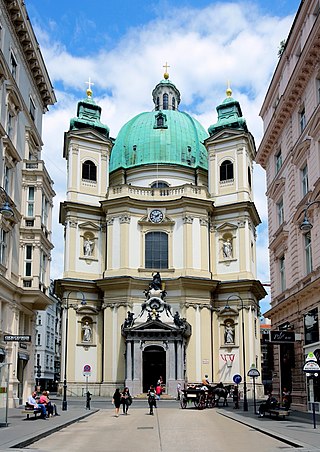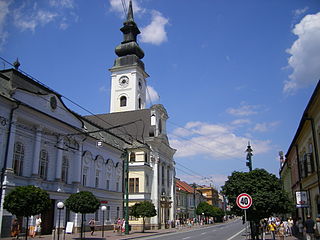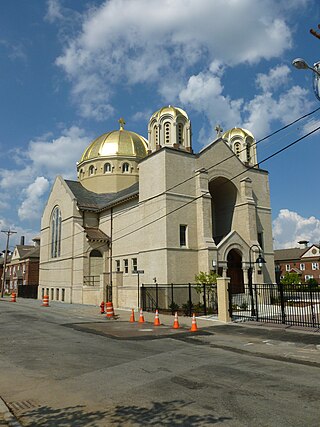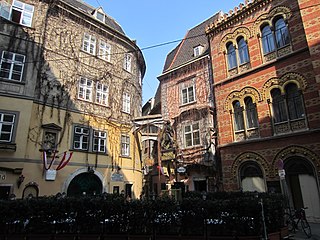
Andrei Rublev was a Russian artist considered to be one of the greatest medieval Russian painters of Orthodox Christian icons and frescoes. He is revered as a saint in the Eastern Orthodox Church, and his feast day is 29 January.

Neo-Byzantine architecture was a revival movement, most frequently seen in religious, institutional and public buildings. It incorporates elements of the Byzantine style associated with Eastern and Orthodox Christian architecture dating from the 5th through 11th centuries, notably that of Constantinople and the Exarchate of Ravenna.

The Holy Trinity Cathedral, also known as Holy Trinity Greek Orthodox Church, is a Greek Orthodox cathedral in Salt Lake City, Utah, United States. Built in 1923, the church was listed on the National Register of Historic Places in 1975.

Baron Theophil Edvard von Hansen was a Danish architect who later became an Austrian citizen. He became particularly well known for his buildings and structures in Athens and Vienna, and is considered an outstanding representative of Neoclassicism and Historicism.

The Peterskirche is a Baroque Roman Catholic parish church in Vienna, Austria. It was transferred in 1970 by the Archbishop of Vienna Franz Cardinal König to the priests of the Opus Dei.

Holy Trinity Orthodox Cathedral is the cathedral church of the Orthodox Church in America Diocese of the Midwest. It is one of only two churches designed by Louis Sullivan, one of the seminal architects of the late 19th and early 20th centuries. It is listed on the US National Register of Historic Places and is designated a Chicago Landmark.
The Archdiocese of Thyateira and Great Britain is an archdiocese of the Ecumenical Patriarchate of Constantinople in the Eastern Orthodox Church. The incumbent archeparch is Nikitas Loulias. Its jurisdiction covers those Orthodox Christians living in the United Kingdom, the Isle of Man, and the Channel Islands. The adherents are largely of Cypriot Greek descent, mainland Greek migrants and their descendants, and more recently native British converts along with a few Poles, Belarusians, and Ukrainians. The episcopal seat is the Cathedral of Holy Wisdom which is situated in London.

Ukrainian Village is a Chicago neighborhood located on the near west side of Chicago. Its boundaries are Division Street to the north, Grand Avenue to the south, Western Avenue to the west, and Damen Avenue to the east. It is one of the neighborhoods in the West Town community area, and has one of the largest concentrations of Ukrainians in the United States, as the commercial and spiritual hub for nearly 70,000 Ukrainians in the greater Chicago region.

Ludwig Thiersch was a German painter, primarily of mythological and religious subjects and especially of ecclesiastical art, also influential in Greece.
The Exarchate of the Philippines is an exarchate or sub-diocesan entity of the Eastern Orthodox Metropolis of Hong Kong and Southeast Asia that is located in the Philippines. The metropolis is one of four metropolises in Asia that are under the jurisdiction of the Ecumenical Patriarchate of Constantinople. The exarchate has five parishes and three chapels in the country.

The Archeparchy of Prešov is an archeparchy of the Slovak Greek Catholic Church which is an Eastern Catholic particular church of the Catholic Church that is in full communion with the Holy See. The archeparchy is the metropolitan see of the Slovak Greek Catholic ecclesiastical province which covers the whole of Slovakia. The archeparch is also, ex officio, the metropolitan bishop of the metropolis. The geographical remit of the archeparchy itself is confined to the Prešov Region of Slovakia. The archeparch is currently Jonáš Maxim. The cathedral church of the archeparcy is the cathedral of St. John the Baptist which is situated in Prešov. As an Eastern Catholic church, it uses the Byzantine Rite in the Slovak and Church Slavonic languages.

Greeks in Austria number between 5,000 and 18,000 people. They are located all around the country, but the main community is located in Vienna.

Holy Trinity Greek Orthodox Church is a historic Greek Orthodox Church building at 62 Lewis Street in Lowell, Massachusetts. Holy Trinity is one of the many Eastern Orthodox churches in Lowell, along with St. George Antiochian Orthodox Church, Transfiguration of Our Savior Greek Orthodox Church, and St. George Greek Orthodox Church. The church is under the jurisdiction of the Greek Orthodox Archdiocese of America and is locally administered by the Metropolis of Boston. The church is located the Downtown Lowell neighborhood known as The Acre. It was built in 1906 and added to the National Register of Historic Places in 1977. Holy Trinity was the first church built for a Greek Orthodox congregation in the United States. It is known for its golden dome, mosaics, iconography, and rich history.
Holy Trinity Greek Orthodox Church may refer to:

Holy Trinity Greek Orthodox Church is located in Sioux City, Iowa, United States. Designed by architect William L. Steele, the church building has been listed on the National Register of Historic Places since 1998.

Saint Nicholas Greek Orthodox Cathedral located at 419 South Dithridge Street in the Oakland neighborhood of Pittsburgh, Pennsylvania, was designed by architect Thomas Hannah and built in 1904. The First Congregational Church built the structure and used it until 1921, but it has been a Greek Orthodox Church since 1923. Currently, it is part of the Greek Orthodox Archdiocese of America, and seat of the Greek Orthodox Metropolis of Pittsburgh. This Classical Revival style church building was added to the List of Pittsburgh History and Landmarks Foundation Historic Landmarks in 1982.

St. Francis of Assisi Church, also known as the Emperor's Jubilee Church and the Mexico Church, is a Basilica-style Catholic church in Vienna, Austria. Built between 1898 and 1910, it was consecrated in 1913. It is located on the Mexikoplatz in Vienna's Second District, Leopoldstadt, and is administered by the Order of the Holy Trinity.

The Metropolitan Cathedral of the Holy and Equal-to-the-Apostles Mary Magdalene is a Polish Orthodox cathedral, located at al. Solidarności 52 in Warsaw.

Griechenbeisl is one of the oldest restaurants in Vienna, Austria. Established in 1447 and having operated under several different names, the restaurant is located on Fleischmarkt 11 near the Holy Trinity Greek Orthodox Church.

















